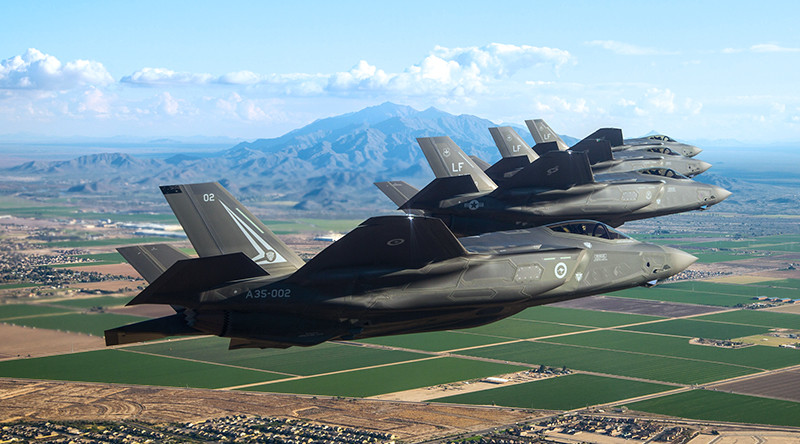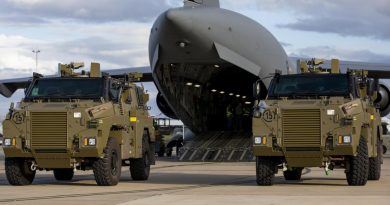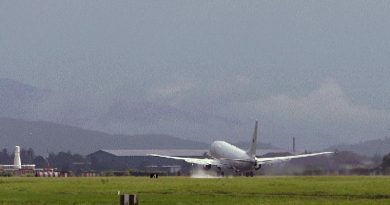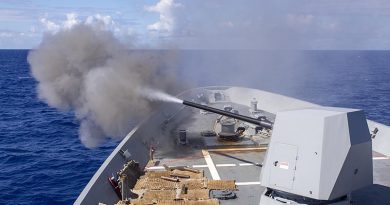BUDGET 2017 – Defence share

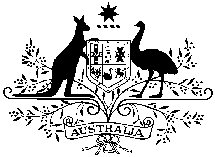
|
SENATOR THE HON MARISE PAYNE |
THE HON CHRISTOPHER PYNE MP |
Budget 2017–18 – Defence Budget Overview
The Turnbull Government’s first priority continues to be the safety and security of Australia and its people.
The 2017–18 Budget provides funding to deliver:
- on our ongoing commitments to Defence Operations around the globe, ensuring safety and security at home and secure maritime borders;
- the capability plans set out in the 2016 Defence White Paper through the Defence Integrated Investment Program; and
- the strategies outlined in the Defence Industry Policy Statement to reshape and refocus the Defence and industry partnership.
The 2017 Budget maintains the Government‘s commitment to provide Defence with a stable and sustainable funding growth path. The Defence budget will grow to two per cent of GDP by 2020–21, three years earlier than the Coalition’s 2013 election commitment. The Government will provide Defence with $34.6 billion in 2017–18 and $150.6 billion over the Forward Estimates.
Over the next decade from 2017–18, the $200 billion Integrated Investment Program demonstrates the Government’s commitment to creating a more potent and capable Defence Force, and growing a local defence industry that will create jobs and drive economic growth, through programs such as:
- The naval shipbuilding program, which will invest $89 billion to develop the Royal Australian Navy of the future while creating a strong and sustainable Australian naval shipbuilding industry.
- The F-35 Joint Strike Fighter program, which will give the Royal Australian Air Force unprecedented capability to combat future threats to our nation.
The Government will also continue to support the expanded functions of the Defence Force Ombudsman (DFO) to provide an additional independent complaints process for allegations of abuse in Defence. The DFO functions will be further expanded in 2017–18 to provide for reparation payments to be made in some circumstances. The DFO function complements the cultural change reforms being implemented by Defence.
The Government also recognises the importance of developing a national approach to a redress scheme for survivors of institutional child sexual abuse as quickly as possible. In support of this priority, Defence will contribute to the implementation funding required to establish the Commonwealth’s Redress Scheme.
ENSURING BEST VALUE FOR TAXPAYERS
The Government recognises the importance of ensuring that every dollar is spent effectively and efficiently. To that end, the Government will realise more than $300 million in savings over the next four years through efficiencies resulting from reductions in the numbers of consultants and contractors used in Defence, as well as making changes to limit the costs of non-operational overseas and business travel.
NAVAL SHIPBUILDING PROGRAM
We have made the strategic decision to modernise the Royal Australian Navy with Australian workers, in Australian shipyards, using Australian steel.
We are investing $89 billion in the continuous build of new submarines, major surface combatants and minor naval vessels and will release the Naval Shipbuilding Plan imminently.
A continuous naval shipbuilding program will modernise our naval fleet, support economic growth, maximise Australian industry involvement and secure thousands of Australian jobs for decades to come. The Government has already commenced significant work to support the success of the Naval Shipbuilding Plan:
- DCNS has commenced design and mobilisation work for the future submarine and Lockheed Martin Australia has been selected as the Combat System Integrator.
- On 20 December 2016, Australia and France signed an inter-governmental agreement concerning cooperation on the future submarine program.
- In April 2017, steel was cut for the first of up to 21 Pacific Patrol Boats at Henderson in Western Australia, representing the start of our continuous naval shipbuilding program.
- A request for tender has been released for the future frigate program and a tender evaluation is underway for shipbuilding designers for the offshore patrol vessels.
- The Government announced an initial investment of $25 million to establish a Naval Shipbuilding College to support workforce growth and the skills needed to deliver a continuous naval shipbuilding program.
- The structural separation of ASC into three individual Government owned entities, supporting the key capabilities of shipbuilding, submarine sustainment, and infrastructure.
- Odense Maritime Technology has been engaged to develop the detailed infrastructure design for the south side of the Osborne Shipyard in Adelaide.
DEFENCE CAPABILITY INVESTMENT
The Defence Integrated Investment Program details Defence’s future capability requirements to ensure the men and women of the ADF have the platforms and equipment they need to keep Australia secure, whether that be at sea, in the air and space, on the land or in the cyber domain.
Since the release of the 2016 Defence White Paper, the Government has committed around $12.2 billion to new capabilities to strengthen our Defence Force, including:
- Approval to commence design of the 12 future submarines, to be built in Australia.
- An investment of up to $2 billion for the Short Range Ground Based Air Defence System which will provide the inner-most layer of Australia’s enhanced integrated air and missile capability.
- A $500 million investment in Australia’s Electronic Warfare Support Operations to boost testing equipment, tools and laboratories to further strengthen the ADF’s electronic warfare capabilities.
SUPPORTING DEFENCE INDUSTRY
The Australian defence industry is front and centre of the Government’s plan for jobs and growth in the Australian economy.
In the 2016 Defence White Paper, the Government announced it would invest $1.6 billion in defence industry and innovation programs over ten years. All three elements of this investment—the Centre for Defence Industry Capability, the Defence Innovation Hub and the Next Generation Technologies Fund are now operational.
The significance of such a large investment in building industry capability and competitiveness cannot be understated. The Government believes investing in this sector will deliver improved capability for Defence and returns for the broader economy.
These initiatives complement the Government’s broader policy initiatives to maximise Australian industry involvement in the development and sustainment of Defence capability.
DEFENCE OPERATIONS
As part of our ongoing commitment to security and stability around the globe, the Government has agreed to continue funding major operations.
Australia currently has around 2,300 Defence personnel deployed around the world including on operations across the Middle East and Afghanistan. The ADF is also fully engaged in the near region, as part of the Government’s commitment to securing Australia’s maritime borders.
Recent attacks in London and Stockholm, following on from earlier attacks in France, Belgium, Turkey, Pakistan, and Indonesia, underscore the importance of Australia’s significant contribution to the US-led counter-Daesh coalition in Iraq and Syria. For this reason, Australia has around 700 personnel deployed as part of Operation OKRA.
The Government is committed to assisting the Government of Afghanistan to control its security and never again become a safe-haven for terrorist networks. Operation HIGHROAD will continue to provide security, development assistance, and capability building for Afghan institutions.
The Government has agreed to an additional $34.2 million for security support for the 2018 Gold Coast Commonwealth Games and Queen’s Baton Relay. Defence will provide niche capabilities in support of Queensland authorities. Defence support is a critical component for the security framework required to deliver a safe and secure environment for the Games.

THE HON DAN TEHAN MP
MINISTER FOR VETERANS’ AFFAIRS
MINISTER FOR DEFENCE PERSONNEL
MINISTER ASSISTING THE PRIME MINISTER FOR CYBER SECURITY
MINISTER ASSISTING THE PRIME MINISTER FOR THE CENTENARY OF ANZAC
Mental health support for veterans and their families, and medical coverage for veterans of nuclear testing
The Government will expand the range of mental health conditions current and former Australian Defence Force (ADF) members can seek treatment for on a non-liability basis as part of the 2017–18 Budget.
The Government will also provide a Gold Card to cover the health care costs of the surviving participants of the British Nuclear Test program in Australia in the 1950s and 1960s and veterans who served as part of the British Commonwealth Occupation Force (BCOF). The Government has allocated $133.1 million for this initiative to cover eligible veterans.
Minister for Veterans’ Affairs Dan Tehan said this year’s Budget represented a significant increase in funding of $350 million in support of veterans and demonstrated the Government’s commitment to the men and women who defend our nation.
“The Government is focused on responding to the mental health needs of our former ADF personnel and providing support that will help them to achieve a fulfilling post‑service life,” Mr Tehan said.
“In last year’s Budget, we made treatment for depression, post-traumatic stress disorder, anxiety, and drug and alcohol misuse free for anyone who had served a day in the full-time ADF.
“The $33.5 million expansion of the non-liability health care program to cover all mental health conditions announced in tonight’s Budget recognises that the earlier a veteran gets treatment, the better the health and other outcomes. This includes access to the Veterans and Veterans Families Counselling Service (VVCS).
“Importantly, a veteran does not have to prove their mental health condition is related to their service. The funding for mental health treatment is demand-driven and not capped – if an eligible person requires treatment, it will be paid for.”
Mr Tehan said the Government understands that partners, families and former partners of veterans are affected by military service. In recognition of this, the Budget will provide $8.5 million to expand eligibility for VVCS.
“The partners and children of our contemporary veterans, who have had one day of full-time service, will have access to the services and support provided by VVCS, including counselling and group programs,” Mr Tehan said.
“Former partners of ADF personnel will also be able to access VVCS up to five years after a couple separates or while co-parenting a child under the age of 18.
“VVCS is the frontline mental health service for those in the veteran community and is a vital service that saves lives. It is available 24/7 on 1800 011 046.”
Mr Tehan said that as an initial step in the Government’s response to the National Mental Health Commission’s report into suicide prevention services, and our broader commitment to addressing mental health issues, it was providing $9.8 million to pilot new approaches to suicide prevention and improve care and support available to veterans.
“The Mental Health Clinical Management Pilot will assess the benefits of providing intensive clinical management to help meet a veteran’s complex mental health and social needs on discharge from a mental health hospital,” Mr Tehan said.
“We will also pilot an expansion of the successful Coordinated Veterans’ Care (CVC) program to improve support for veterans with both chronic physical and mental health conditions as a result of their service.”
Mr Tehan said the Government would provide $2.7 million for the Prime Minister’s Veterans’ Employment Program, launched in November last year.
“The money will be used to support the recently established Industry Advisory Committee, create an Ex-Service Organisation Industry partnership register and develop and manage the annual Prime Minister’s Veterans’ Employment Awards.
“The Prime Minister’s Veterans’ Employment Program is about helping business appreciate the unique skills former ADF members can bring to a job. Helping our former Defence personnel find meaningful post-service careers is one of the best ways we can honour their service and sacrifice.”
Mr Tehan said funding of $166.6 million would be provided in this year’s Budget to implement the first stage of Veteran Centric Reform to modernise the Department of Veterans’ Affairs (DVA) antiquated ICT systems to provide easier access to DVA services.
“This is a significant investment to improve how the Department meets the needs of its clients and is a critical part of bringing DVA’s ICT into the 21st century,” Mr Tehan said.
“As part of this, DVA will implement a suite of initiatives to support members to successfully transition out of the ADF, such as conducting a two-year trial that will allow veterans to access medical treatment while their Military Rehabilitation and Compensation Act 2004 or Safety, Rehabilitation and Compensation Act 1988 claims are processed.
“Veterans and their families have told us there were problems with the way DVA processed claims. We have listened and we have responded with money to deliver better support and services for veterans, underpinned by digital access, streamlined processes and modern technology.”
The Government has committed an additional $19.6 million over two years to support domestic and international commemorative activities for the Anzac Centenary and Century of Service, and the 100thanniversary of the Armistice of the First World War on Remembrance Day, 11 November 2018.
Additional Budget measures for veterans include:
-
$18.0 million as part of the Government’s Energy for the Future Package so more than 235,000 DVA clients will receive a one-off payment for energy bills
-
$9.1 million for accelerated access to rehabilitation services, streamlined access to Incapacity Payments, and improved access to the Totally and Permanently Incapacitated disability pension for veterans working past the age of 65
-
$1.2 million to continue the income support bonus for DVA clients receiving an Education Allowance under either the Veterans’ Children Education Scheme (VCES), or the Military Rehabilitation and Compensation Act Education and Training Scheme (MRCAETS)
$5.0 million to develop a first pass business case for the Australian War Memorial to examine ways to provide additional exhibition space.
.
.
.
.
.
.
.

.
.

